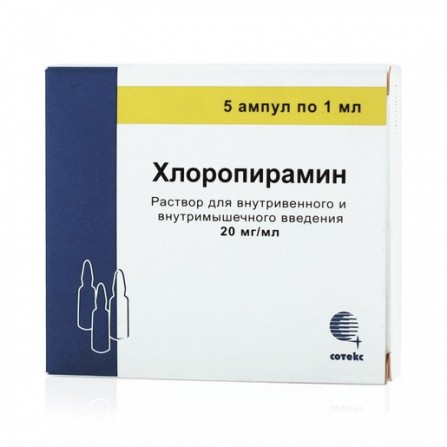Chloropyramine solution for in 20mg ml ampoules 1ml N5
Condition: New product
1000 Items
Rating:
Be the first to write a review!

More info
Description
Chloropyramine is a solution for intramuscular and intravenous administration, which has anti-allergic and antipruritic effect.
Active ingredients
Chloropyramine
Composition
Chloropyramine hydrochloride, water for injection.
Pharmacological effect
Chloropyramine has anti-allergic and antipruritic effects.
Pharmacokinetics
Chloropyramine is a blocker of H1 receptors. Chemical structure refers to ethylenediamine derivatives. Chloropyramine selectively inhibits histamine H1 receptors and reduces capillary permeability. Prevents the development and facilitates the course of allergic reactions. It has a sedative and pronounced antipruritic effect. It has moderate peripheral anticholinergic and antispasmodic activity and antiemetic effect.
Indications
Allergic diseases, including: urticaria, rhinitis, conjunctivitis, pollinosis (hay fever), angioedema, serum sickness, drug allergy, skin diseases, including: eczema, contact dermatitis, skin itch, neurodermatitis, toxicoderma.
Contraindications
Individual hypersensitivity to the drug Chloropyramine, simultaneous use of monoamine oxidase inhibitors, newborns, pregnancy and lactation. Peptic ulcer in the acute stage. Closed angle glaucoma. Prostate hyperplasia. Respiratory failure.
Precautionary measures
The drug should be administered with caution to elderly patients, with insufficient liver function and / or heart disease, with peptic ulcer of the gastrointestinal tract, while taking medications that depress the central nervous system.
Use during pregnancy and lactation
Contraindicated in pregnancy and lactation.
Dosage and administration
Intramuscularly or intravenously. Adults appoint 20-40 mg per day (the contents of 1-2 ampoules). Treatment in children begin with a dose of 5 mg (0.25 ml). Further increase in the dose is limited mainly by the appearance of side effects. Children aged 1-12 months - 5 mg (0.25 ml). Children aged 2-6 years -10 mg (0.5 ml). Children aged 7-14 years-10-20 mg (0.5-1 ml). The daily dose should not exceed 2 mg / kg body weight.In severe allergies, treatment should begin with an injection form of chloropyramine. At first, it is administered intravenously slowly, then transferred to intramuscular administration, and in the final phase of treatment they are transferred to the ingestion of pills.
Side effects
From the side of the central nervous system: lethargy, weakness, drowsiness, dizziness, headache, euphoria, feeling tired, irritable, tremors, convulsions, impaired coordination of movements, impaired vision, in children some stimulating effect on WYC, manifested by anxiety, increased irritability, insomnia. On the part of the digestive system: dry mouth, nausea, vomiting, gastralgia, diarrhea / constipation, loss or increase in appetite. From the urinary system: difficulty urinating. On the part of the cardiovascular system: decrease in blood pressure (more often in elderly patients), tachycardia, arrhythmia. On the side of the hematopoietic system: very rarely - leukopenia, agranulocytosis. On the part of the organs of vision: increased intraocular pressure. Other: photosensitivity, muscle weakness. Allergic reactions to the drug.
Overdose
Symptoms: in children - excitement, anxiety, hallucinations, athetosis, ataxia, convulsions, mydriasis, stiffness of the pupils, flushing of the skin of the face, hyperthermia, then collapse, coma. In adults, depression (inhibition, depression) or excitation of the central nervous system (psychomotor agitation), very rarely, are hallucinations, a disorder of coordination, pupil dilation and the absence of their reaction to light, dry mouth, hyperthermia and skin hyperemia, cramps, in severe cases - coma. Treatment: symptomatic therapy (including the appointment of anti-epileptic drugs, caffeine, phenamine), resuscitation measures, artificial ventilation of the lungs - according to indications. There is no specific antidote.
Interaction with other drugs
Enhances the effect of drugs for general anesthesia, hypnotic drugs, sedative drugs, tranquilizers, m-anticholinergics, opioid analgesics, local anesthetics. Tricyclic antidepressants and MAO inhibitors increase m-anticholinergic and inhibitory effects on the central nervous system. Caffeine and phenamine reduce the inhibitory effect on the central nervous system.Simultaneous use with ethanol is not recommended (risk of severe depression of the central nervous system).
special instructions
The drug should be administered with caution to elderly patients, with insufficient liver function and / or heart disease, with peptic ulcer of the gastrointestinal tract, while taking medications that depress the central nervous system.





